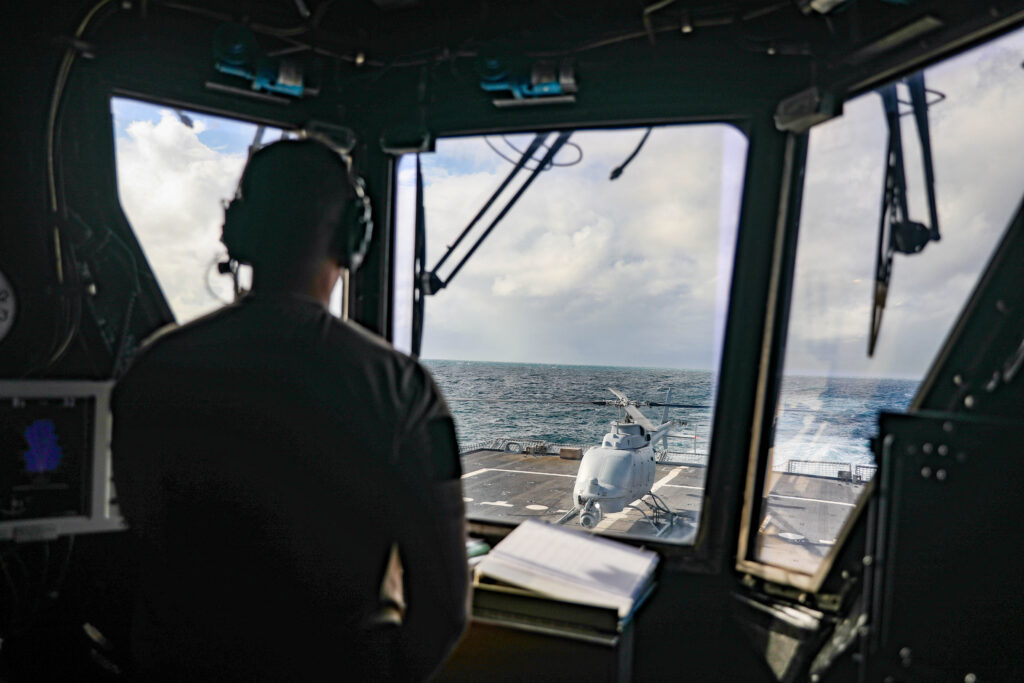
ARLINGTON, Va. — The U.S. Navy’s MQ-8C Fire Scout unmanned helicopter reached initial operational capability more than 2.5 years ago but made its first operational deployment only last month. The reason, the Navy’s program manager explained, centered on the integration of a radar into the new Fire Scout version.
Navy Capt. Eric Soderberg, the Navy’s Fire Scout program manager, speaking to reporters Jan. 25, explained the MQ-8C as a platform reached initial operational capability in June 2019, but the service decided to wait until it could complete integration of the Leonardo ZPY-8 surface search radar on the MQ-8C, which has now been accomplished. The radar already was integrated on the older MQ-8B version, which the MQ-8C is scheduled to replace.
Soderberg said that “the fleet made a decision that a radar-equipped Bravo [MQ-8B] was more suitable to deploy than a non-radar-equipped Charlie [MQ-8C]. Now that we have that radar on the Charlie, it becomes a pretty clear answer that the Charlie is the superior platform, and that’s why we’re accelerating the transition from the 8B to the 8C.”
An MQ-8C, built by Northrop Grumman, was deployed operationally on Dec. 14 on board the Freedom-class littoral combat ship USS Milwaukee (LCS 5), which is deployed in the U.S. 4th Fleet’s area of operations in support of Joint Interagency Task Force South’s mission, which includes counter-illicit drug trafficking missions in the Caribbean and Eastern Pacific, according to the caption.
Soderberg said the MQ-8C was “performing up to expectations” on the deployment.
The Leonardo ZPY-8 on the Fire Scout gives the host ship a far greater ability to detect and track surface contacts and maintain over-the-horizon situational awareness.
The MQ-8C’s larger airframe and greater fuel load gives it an endurance is 10 to 12 hours, far greater than the four to five hours of the MQ-8B.
The improved software on the MQ-8C system eases the workload on the controllers. The software integrates the radar, electro-optical sensor, and Automatic Information System in the MQ-8C.
The MQ-8C on the Milwaukee is teamed with an MH-60S Seahawk helicopter, which is not equipped with a radar. Both aircraft are operated by the “Sea Knights” of Helicopter Sea Combat Squadron (HSC) 22, Detachment 5.
Soderberg said although the detachment’s officers all can control the Fire Scout, one officer is assigned as the main specialist for the system. The Navy also is qualifying MQ-8B and MQ-8C operators separately now, as opposed to personnel operating both types.
The program manager also said a data link designed to allow the MQ-8C to share sensor data with multiple platforms is being introduced, but some budget uncertainty is slowing that process.
He said there is a well-defined need for a mine-countermeasures sensor with both littoral surf zone and deeper water capabilities. The COBRA II sensor, equipped with lidar, is considered suitable.
A passive electronic warfare sensor for the platform is under discussion. Soderberg also said there is a “technical way forward” to arm the MQ-8C with weapons such as rockets, but there are “no funded efforts to implement” a weapons
He also said the MQ-8C is ready if needed for on the Lewis B. Puller-class expeditionary sea base ship. The mobile mission-control station is ready and certified for the ship.






